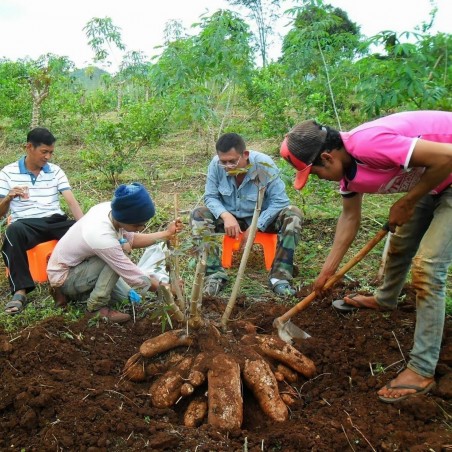
- +00 123 4567
- support@seeds-gallery.shop
seeds-gallery.shop
✨ Cassava (Manihot esculenta), also called yuca, manioc, macaxeira, mandioca, or aipim, is a woody shrub native to South America in the spurge family (Euphorbiaceae). Although perennial, it is commonly cultivated as an annual crop for its starchy tuberous roots, which are a major carbohydrate source. Cassava is widely consumed boiled, or processed into starch (tapioca), flours like Brazilian farinha or West African garri, and used in animal feed and industrial products.
Roots: Long, tapered, firm, with a thin (≈1 mm) brown rind. Flesh can be chalk-white or yellowish. Rich in starch, low in protein.
Leaves: Good protein source (rich in lysine) but deficient in methionine and possibly tryptophan.
Varieties: Cassava is classified as sweet or bitter. Bitter varieties contain more cyanogenic compounds and require proper preparation to avoid toxicity. Sweet cassava can be boiled safely. Bitter cassava often serves as a “food security crop” in times of famine.
History & Cultivation:
Domesticated in west-central Brazil ~10,000 years ago. Archaeological evidence shows cultivation in Mexico and El Salvador by 4,600 BC.
Introduced to Africa (16th century) and Asia through the Columbian Exchange. Now widely grown in Indonesia, Thailand, Vietnam, China, and parts of Africa.
Production: Major producers – Nigeria (largest), Thailand, Brazil, Indonesia.
Climate: Thrives in tropical/subtropical regions, latitudes ±30°, elevations 0–2,000 m, tolerates poor soils and drought.
Uses:
Food: Boiled, baked, fried, flour, cakes, breads, farofa, garri
Starch: Tapioca, noodles, industrial use
Alcoholic beverages: Cauim, tiquira, kasiri, masato, etc.
Nutritional Profile (per 100 g raw):
Energy: 160 kcal
Carbohydrates: 38.1 g
Protein: 1.4 g
Fat: 0.3 g
Dietary fiber: 1.8 g
Vitamin C: 25% DV
Calcium: 2% DV, Iron: 2% DV, Magnesium: 6% DV, Phosphorus: 4% DV, Potassium: 6% DV
Important Notes:
Cassava contains cyanogenic glycosides, especially in bitter varieties. Proper processing is required to remove toxins. Sweet varieties are safe after boiling.
🌏 Global Impact:
Cassava is a staple for ~800 million people worldwide, especially in sub-Saharan Africa, South America, and parts of Asia. Highly productive per hectare, drought-tolerant, and suitable for marginal soils.
🔗 More info:
📘 Wikipedia: Cassava


Your review appreciation cannot be sent
Report comment
Report sent
Your report cannot be sent
Write your review
Review sent
Your review cannot be sent
We ship worldwide from the European Union using registered air post with signature confirmation on delivery.
Log in to your account and go to Order History > Details to find your tracking number.
You will receive email notifications at every step — please check your spam/junk folder if you don’t see them.
Track your package via:
Cash on delivery is not available.
Always provide a valid mobile number with country code when ordering (e.g., +365 456 7686 576).
Do not order to P.O. Boxes or if you cannot be home to sign for the package. We cannot leave parcels with neighbors.
If a package sent to a P.O. Box is lost or undelivered, you lose the right to a refund.
For customers in Brazil and Mexico:
We cannot refund packages lost or destroyed by customs.
If your package is returned, we will refund only the product cost — shipping costs are not refundable.
You must pay return postage (€2) and any costs for reshipping.
If a package is returned to us for any reason, you are responsible for paying the return shipping (€2) plus the cost to resend the package.
Registered shipments require a signature from the recipient.
If your tracking shows the package is still at the origin post office, it means the package is in transit — please contact your local post office directly for updates.
We are not responsible for delivery times and cannot track shipments for you.
| Delivery Option | Processing Time | Notes |
|---|---|---|
| Priority Delivery | Ships in 1-7 business days | Prioritizes order processing (not guaranteed faster delivery); delays possible during holidays (3-10 days) |
| Secured Delivery | Ships in 1-7 business days | Available for orders up to €150; refund if lost |
| Standard Delivery | Ships in 7-10 business days | More economical; delays possible during holidays (7-14 days) |
Estimated Delivery Time:
Within the EU: 3–20 days
Worldwide: 5–30 days
Example delivery times to the USA:
Delivered in 13, 17, 19, 22, or 27 days.
Note: Delivery times depend on your location and the local postal system. COVID-19 may cause additional delays.
Shipping and handling fees are calculated automatically during checkout based on the weight of the parcel and the destination country.
We do not process or ship orders on Saturdays or Sundays.
Bank Transfer (SEPA / IBAN / SWIFT-BIC)
Include your order reference in the payment description (e.g., "SGS-19811702"). Orders without payment within 7 days are automatically cancelled.
PayPal
Payments accepted in Euros only. Please select Euros at checkout.
Card Payment
For card payments, visit our other site: Exotic Seeds Store
We accept Visa, MasterCard, American Express, CB, Diners Club, Discover, China UnionPay, JCB, and Discover.
Customers are responsible for any transaction fees. Please provide payment details to help us process your order efficiently.
Before placing your order, please check our website for any special notices, holiday schedules, or specific conditions that may affect your purchase.